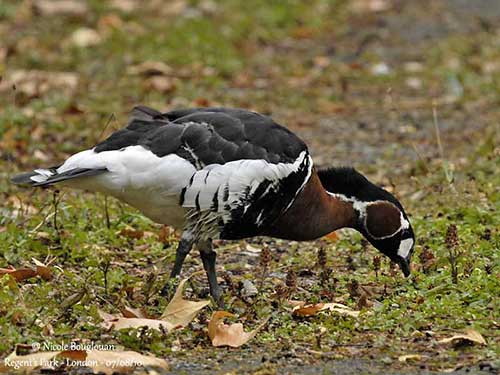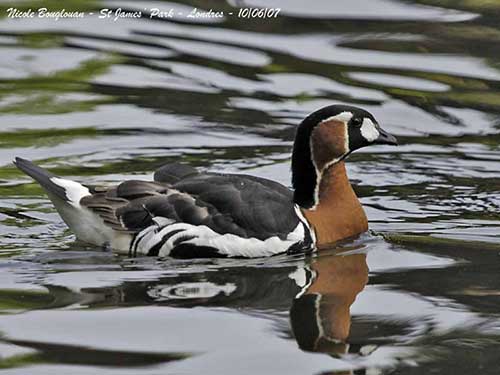
Fr: Bernache à cou roux
Ang: Red-breasted Goose
All: Rothalsgans
Esp: Barnacla cuelliroja
Ita: Oca collorosso
Nd: Roodhalsgans
Sd: rödhalsad gås
Photographer:
Nicole Bouglouan
Photographic ramble & My pictures on IBC
Text by Nicole Bouglouan
Sources :
HANDBOOK OF THE BIRDS OF THE WORLD vol 1 by Josep del Hoyo-Andrew Elliot-Jordi Sargatal - Lynx Edicions - ISBN: 8487334105
THE HANDBOOK OF BIRD IDENTIFICATION FOR EUROPE AND THE WESTERN PALEARCTIC by Mark Beaman, Steve Madge - C. Helm - ISBN: 0713639601
GUIDE DES CANARDS, DES OIES ET DES CYGNES – de Steve Madge - Delachaux et Niestlé - ISBN: 2603013769
BIRDS OF THE MIDDLE EAST by R.F. Porter, S. Christensen, P Schiermacker-Ansen C.Helm - ISBN: 0713670169
Wikipedia, the free encyclopaedia
IUCN Red List of Threatened Species
Durrell Wildlife Conservation Trust
AEWA International Working Group for the Red-breasted Goose
Royal Belgian Institute of Natural Sciences
BSPB – Bulgarian Society for the Protection of Bird
Green Balkans Conservation Programme
Red-breasted Goose
Branta ruficollis
Anseriformes Order – Anatidae Family
INTRODUCTION:
The Red-breasted Goose is an unmistakable small goose with brightly coloured plumage. It is the smallest goose of the genus Branta, but it can be inconspicuous at long ranges because the red parts of the body tend to look very black. It is then very similar to the Brant Goose.
This species breeds in W Siberian Arctic where the lasts mammoths used to live. It spends the winter along the coasts of Black Sea and Caspian Sea.
The population of the Red-breasted Goose is declining due to land-use changes, hunting, pesticides and tourism development. The species is currently listed as Vulnerable.

DESCRIPTION OF THE BIRD:
Biometrics:
Length: 53-56 cm
Wingspan: 116-135 cm
Weight: M: 1200-1625 g – F: 1055-1130 g
The Red-breasted Goose has black crown, nape, back, wings, belly and tail. On the upperwing, the wing-coverts are crossed by narrow white bars. Rump and uppertail-coverts are white.
Foreneck and breast are chestnut-red, bordered with white. When the bird feeds head-on, the white breast band appears almost to encircle the body. Flanks, vent and undertail-coverts are white, with black bars on rear flanks.
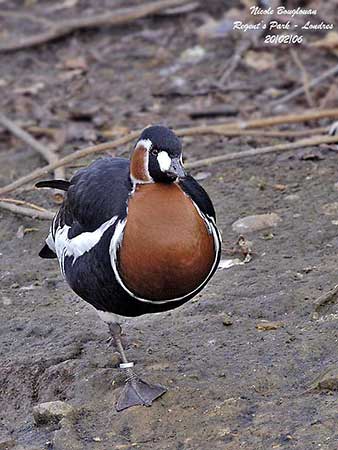
On the head, crown, nape and face are black, except the conspicuous white lores. We can see a chestnut-red patch on head side, surrounded by a narrow white stripe.
The short bill is black. The eyes are dark brown. Legs and feet are black.
Male and female are fairly similar, although in male, the forehead rises more vertically from top of the bill than in female.
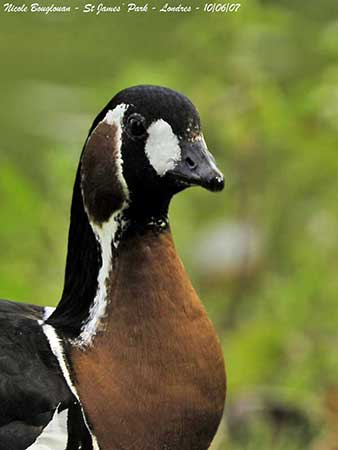
The juvenile is duller and shows white spotting on sides and mantle. The chestnut patches are less clearly defined, especially the cheek patch which is smaller and mostly grey. Flanks are less barred. It is sexually mature at 3-4 years old.
RANGE:
The Red-breasted Goose breeds in the Siberian tundra, within Taymyr Peninsula, and in Gydan and Yamal Peninsulas.
It winters in SE Europe and SW Asia, and mainly on N and W coasts of Black sea and Caspian Sea.
This species is a rare vagrant to Great Britain and some other W European regions. The wintering grounds in Kirov Bay in the Caspian Sea have become unsuitable for this species since the 1960s, due to land-use changes. The usual cereal crops are now replaced by vineyards. Although being much localized, the species winters in coastal Romania and adjacent Bulgaria.
HABITAT:
The Red-breasted Goose nests in the tundra, and mainly in open areas covered with dry shrubs and lichens. It especially favours high and dry areas such as rocky slopes, crags and gullies, or steep river banks, but usually not far from water.
During winter, it frequents open steppe and lowland with hills. It feeds in pastures, stubble and crops. They roost on lakes and in remote wetlands.
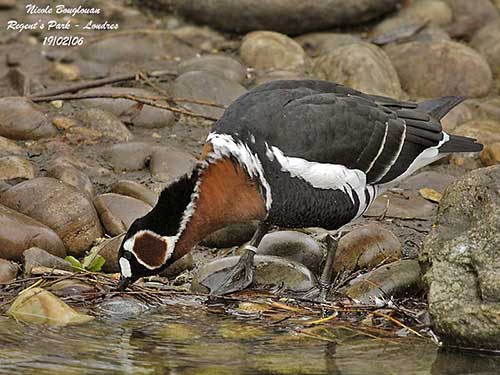
CALLS AND SONGS: SOUNDS BY XENO-CANTO
The Red-breasted Goose’s typical flight call is a repeated, squeaky, shrill “kik-yoik, kik-yik”. During aggressive displays, the geese produce hisses while adopting threatening postures, often with raised nape feathers.
BEHAVIOUR IN THE WILD:
The Red-breasted Goose has a vegetal diet, and feeds on sedges and other aquatic plants, taking leaves, green parts and stems during winter. It also consumes wheat, barley, maize, grain and tubers.
This species is gregarious in winter and often feeds in mixed-species flocks including other geese. When they are feeding in flocks, they utter continuously high-pitched calls. They feed mainly by grazing on the ground.
During summer, the diet includes mainly grass leaves and shoots of Eriophorum plant species, and also Carex and Equisetum.
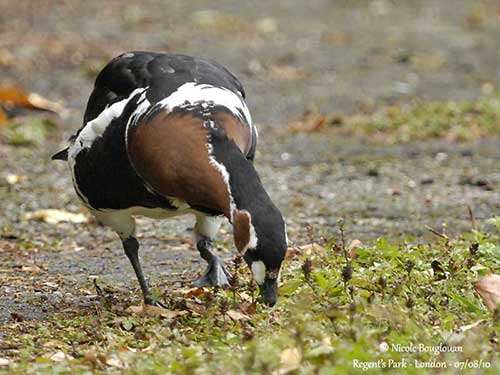
During the nesting period, the Red-breasted Goose often selects a nest-site close to raptor’s nest, often Peregrine Falcon that provides them a good protection from predators such as the Arctic foxes. They really live together, and usually, the geese nest on cliffs or steep slopes, a few metres from the falcons. Potential predators are chased away by the male falcon and the geese benefit from this behaviour. However, in winter and during migration, the geese are good prey for the falcons…
The Red-breasted Goose breeds in small colonies of 4-8 pairs.
The Red-breasted Goose is highly migratory. They leave the Siberian breeding grounds from mid to late September, following a narrow migration route. They reach the wintering grounds in October/November, sometimes in late December.
They leave the wintering areas between late February and early May, but they often remain up to one month at stopover sites.
They move in tight groups, rather than in regular V formation. The flight is fast and agile. The plumage looks very dark and contrasts strongly with the white lower belly.
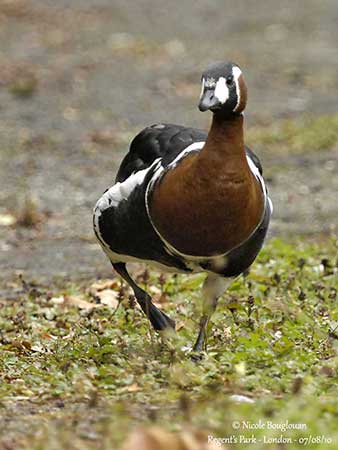
REPRODUCTION OF THIS SPECIES:
The breeding season starts in June. The Red-breasted Goose breeds in small, loose groups of 4-8 pairs, sometimes more, with the nests a few metres apart.
The nest is on the ground, a shallow structure made with vegetation and lined with grass and dark down. It is often placed on steep ground, riverbanks, rocky islands or rocky outcrops, and close to raptor’s nests.
The female lays a single brood per season of 6-7 creamy-white eggs, and she incubates alone guarded by the male close to the nest. At hatching, the downy chicks are dark brown above and pale yellow below. They leave the nest within 24-36 hours after hatching. They follow their parents to the feeding sites, often several kilometres from the colony. They fledge between 35 and 42 days after hatching.
The Red-breasted Goose is vulnerable to predation by Arctic foxes, Larus argentatus, skuas and probably Snowy Owls.
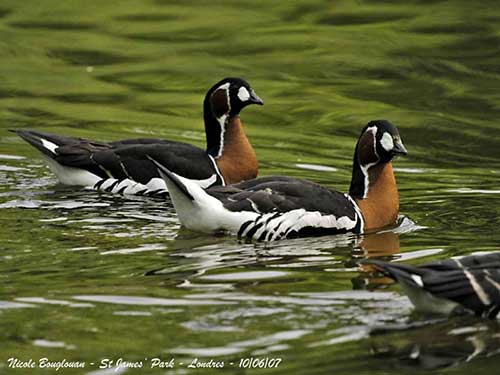
PROTECTION / THREATS / STATUS:
The Red-breasted Goose is threatened by land-use changes in some parts of the wintering grounds, hunting and disturbance by hunters on feeding areas, pesticides and tourism development. Natural predation has a significant impact too.
The population is not clearly quantified, depending on migratory birds. However, the numbers are decreasing and the Red-breasted Goose is currently listed as Vulnerable.
